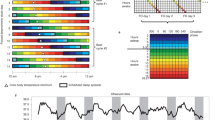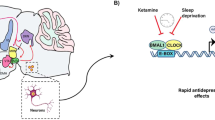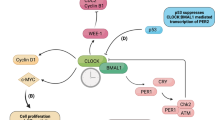Abstract
Recent studies have shown that functional variations in clock genes, which generate circadian rhythms through interactive positive/negative feedback loops, contribute to the development of circadian rhythm sleep disorders in humans. Another potential candidate for rhythm disorder susceptibility is casein kinase I epsilon (CKIɛ), which phosphorylates clock proteins and plays a pivotal role in the circadian clock. To determine whether variations in CKIɛ induce vulnerability to human circadian rhythm sleep disorders, such as delayed sleep phase syndrome (DSPS) and non-24-h sleep–wake syndrome (N-24), we analyzed all of the coding exons of the human CKIɛ gene. One of the variants identified encoded an amino-acid substitution S408N, eliminating one of the putative autophosphorylation sites in the carboxyl-terminal extension of CKIɛ. The N408 allele was less common in both DSPS (p=0.028) and N-24 patients (p=0.035) compared to controls. When DSPS and N-24 subjects were combined, based on an a priori prediction of a common mechanism underlying both DSPS and N-24, the inverse association between the N408 allele and rhythm disorders was highly significant (p=0.0067, odds ratio=0.42, 95% confidence interval: 0.22–0.79). In vitro kinase assay revealed that CKIɛ with the S408N variation was ∼1.8-fold more active than wild-type CKIɛ. These results indicate that the N408 allele in CKIɛ plays a protective role in the development of DSPS and N-24 through alteration of the enzyme activity.
Similar content being viewed by others
Log in or create a free account to read this content
Gain free access to this article, as well as selected content from this journal and more on nature.com
or
References
Akashi M, Tsuchiya Y, Yoshino T, Nishida E (2002). Control of intracellular dynamics of mammalian period proteins by casein kinase Iɛ (CKIɛ) and CKIδ in cultured cells. Mol Cell Biol 22: 1693–1703.
Ancoli-Israel S, Schnierow B, Kelsoe J, Fink R (2001). A pedigree of one family with delayed sleep phase syndrome. Chronobiol Int 18: 831–840.
Ando K, Kripke DF, Ancoli-Israel S (1995). Estimated prevalence of delayed and advanced sleep phase syndromes. Sleep Res 24: 509.
Burset M, Seledtsov IA, Solovyev VV (2000). Analysis of canonical and non-canonical splice sites in mammalian genomes. Nucleic Acids Res 28: 4364–4375.
Camacho F, Cilio M, Guo Y, Virshup DM, Patel K, Khorkova O et al (2001). Human casein kinase Iδ phosphorylation of human circadian clock proteins period 1 and 2. FEBS Lett 489: 159–165.
Campbell SS, Murphy PJ, van den Heuvel CJ, Roberts ML, Stauble TN (1999). Etiology and treatment of intrinsic circadian rhythm sleep disorders. Sleep Med Rev 3: 179–200.
Cegielska A, Gietzen KF, Rivers A, Virshup DM (1998). Autoinhibition of casein kinase Iɛ (CKIɛ) is relieved by protein phosphatases and limited proteolysis. J Biol Chem 273: 1357–1364.
den Dunnen JT, Antonarakis E (2001). Nomenclature for the description of human sequence variations. Hum Genet 109: 121–124.
Ebisawa T, Uchiyama M, Kajimura N, Mishima K, Kamei Y, Katoh M et al (2001). Association of structural polymorphisms in the human period3 gene with delayed sleep phase syndrome. EMBO Rep 2: 342–346.
Eide EJ, Virshup DM (2001). Casein kinase I: another cog in the circadian clockworks. Chronobiol Int 18: 389–398.
Gietzen KF, Virshup DM (1999). Identification of inhibitory autophosphorylation sites in casein kinase Iɛ. J Biol Chem 274: 32063–32070.
Graves PR, Roach PJ (1995). Role of COOH-terminal phosphorylation in the regulation of casein kinase Iδ. J Biol Chem 270: 21689–21694.
Harmer SL, Panda S, Kay SA (2001). Molecular bases of circadian rhythms. Annu Rev Cell Dev Biol 17: 215–253.
Iwase T, Kajimura N, Uchiyama M, Ebisawa T, Yoshimura K, Kamei Y et al (2002). Mutation screening of the human Clock gene in circadian rhythm sleep disorders. Psychiatry Res 109: 121–128.
Johansson C, Willeit M, Smedh C, Ekholm J, Paunio T, Kieseppa T et al (2003). Circadian clock-related polymorphisms in seasonal affective disorder and their relevance to diurnal preference. Neuropsychopharmacology 28: 734–739.
Jones CR, Campbell SS, Zone SE, Cooper F, DeSano A, Murphy PJ et al (1999). Familial advanced sleep-phase syndrome: a short-period circadian rhythm variant in humans. Nat Med 5: 1062–1065.
Kamgar-Parsi B, Wehr TA, Gillin JC (1983). Successful treatment of human non-24-h sleep–wake syndrome. Sleep 6: 257–264.
Keesler GA, Camacho F, Guo Y, Virshup D, Mondadori C, Yao Z (2000). Phosphorylation and destabilization of human period1 clock protein by human casein kinase Iɛ. Neuroreport 11: 951–955.
Lee C, Etchegaray J-P, Cagampang FRA, Loudon ASI, Reppert SM (2001). Posttranslational mechanisms regulate the mammalian circadian clock. Cell 107: 855–867.
Lee C, Weaver DR, Reppert SM (2004). Direct association between mouse PERIOD and CKIɛ is critical for a functioning circadian clock. Mol Cell Biol 24: 584–594.
Liu F, Virshup DM, Nairn AC, Greengard P (2002). Mechanism of regulation of casein kinase I activity by group I metabotropic glutamate receptors. J Biol Chem 277: 45393–45399.
Lowrey PL, Shimomura K, Antoch MP, Yamazaki S, Zemenides PD, Ralph MR et al (2000). Positional syntenic cloning and functional characterization of the mammalian circadian mutation tau. Science 288: 483–491.
McArthur AJ, Lewy AJ, Sack RL (1996). Non-24-h sleep–wake syndrome in a sighted man: circadian rhythm studies and efficacy of melatonin treatment. Sleep 19: 544–553.
Oren DA, Wehr TA (1992). Hypernyctohemeral syndrome after chronotherapy for delayed sleep phase syndrome. New Engl J Med 327: 1762.
Perneger TV (1998). What's wrong with Bonferroni adjustments. Br Med J 316: 1236–1238.
Price JL, Blau J, Rothenfluh A, Abodeely M, Kloss B, Young MW (1998). Double-time is a novel Drosophila gene that regulates PERIOD protein accumulation. Cell 94: 83–95.
Ralph MR, Menaker M (1988). A mutation of the circadian system in golden hamsters. Science 241: 1225–1227.
Regestein QR, Monk TH (1995). Delayed sleep phase syndrome: a review of its clinical aspects. Am J Psychiatry 152: 602–608.
Reid KJ, Chang A-M, Dubocovich ML, Turek FW, Takahashi JS, Zee PC (2001). Familial advanced sleep phase syndrome. Arch Neurol 58: 1089–1094.
Reppert SM, Weaver DR (2002). Coordination of circadian timing in mammals. Nature 418: 935–941.
Rivers A, Gietzen KF, Vielhaber E, Virshup DM (1998). Regulation of casein kinase Iɛ and casein kinase Iδ by an in vivo futile phosphorylation cycle. J Biol Chem 273: 15980–15984.
Rothenfluh A, Abodeely M, Young MW (2000). Short-period mutations of per affects a double-time-dependent step in the Drosophila circadian clock. Curr Biol 10: 1399–1402.
Schrader H, Bovim G, Sand T (1993). The prevalence of delayed and advanced sleep phase syndromes. J Sleep Res 2: 51–55.
Shibui K, Uchiyama M, Okawa M (1999). Melatonin rhythms in delayed sleep phase syndrome. J Biol Rhythms 14: 72–76.
Takano A, Shimizu K, Kani S, Buijs RM, Odaka M, Nagai K (2000). Cloning and characterization of rat casein kinase 1ɛ. FEBS Lett 477: 106–112.
Toh KL, Jones CR, He Y, Eide EJ, Hinz WA, Virshup DM et al (2001). An hPer2 phosphorylation site mutation in familial advanced sleep phase syndrome. Science 291: 1040–1043.
Uchiyama M, Okawa M, Shibui K, Kim K, Tagaya H, Kudo Y et al (2000). Altered phase relation between sleep timing and core body temperature rhythm in delayed sleep phase syndrome and non-24-h sleep–wake syndrome in humans. Neurosci Lett 294: 101–104.
Uchiyama M, Shibui K, Hayakawa T, Kamei Y, Ebisawa T, Tagaya H et al (2002). Larger phase angle between sleep propensity and melatonin rhythms in sighted humans with non-24-h sleep–wake syndrome. Sleep 25: 83–88.
Vielhaber E, Eide E, Rivers A, Gao Z-H, Virshup DM (2000). Nuclear entry of the circadian regulator mPER1 is controlled by mammalian casein kinase Iɛ. Mol Cell Biol 20: 4888–4899.
Weitzman ED, Czeisler CA, Coleman RM, Spielman AJ, Zimmerman JC, Dement W (1981). Delayed sleep phase syndrome. A chronobiological disorder with sleep-onset insomnia. Arch Gen Psychiatry 38: 737–746.
Wijnen H, Boothroyd C, Young MW, Claridge-Chang A (2002). Molecular genetics of timing in intrinsic circadian rhythm sleep disorders. Ann Med 34: 386–393.
Yazaki M, Shirakawa S, Okawa M, Takahashi K (1999). Demography of sleep disturbances associated with circadian rhythm disorders in Japan. Psychiat Clin Neurosci 53: 267–268.
Acknowledgements
We wish to express appreciation for the cooperation of all the participants. We thank Dr Mariko Nagao, Dr Keiko Kim, and Dr Yoshihisa Kudo for recruiting patients. Technical contributions by Mr Eiichi Yamada, Ms Kyoko Ohnishi, and Mr Masakazu Kinoshita are gratefully acknowledged. This work was supported financially by the Ministry of Health and Welfare, and the Ministry of Education, Science, Sports, and Culture (10557089, 11233206, 12470198), and Saitama Medical School.
Author information
Authors and Affiliations
Corresponding author
Rights and permissions
About this article
Cite this article
Takano, A., Uchiyama, M., Kajimura, N. et al. A Missense Variation in Human Casein Kinase I Epsilon Gene that Induces Functional Alteration and Shows an Inverse Association with Circadian Rhythm Sleep Disorders. Neuropsychopharmacol 29, 1901–1909 (2004). https://doi.org/10.1038/sj.npp.1300503
Received:
Revised:
Accepted:
Published:
Issue date:
DOI: https://doi.org/10.1038/sj.npp.1300503
Keywords
This article is cited by
-
A missense variant in PER2 is associated with delayed sleep–wake phase disorder in a Japanese population
Journal of Human Genetics (2019)
-
GWAS of 89,283 individuals identifies genetic variants associated with self-reporting of being a morning person
Nature Communications (2016)
-
A Population-based Association Study of Casein Kinase 1 Epsilon Loci with Heroin Dependence in Han Chinese
Journal of Molecular Neuroscience (2014)
-
Analysis of the molecular pathophysiology of sleep disorders relevant to a disturbed biological clock
Molecular Genetics and Genomics (2013)
-
Testing for associations between candidate genes for circadian rhythms and individual variation in sleep behaviour in blue tits
Genetica (2012)



